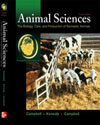
State of Being of Domestic Animals |  |
Chapter Summary| The state of being of agricultural animals residing in modern production systems is a public issue in North America and many other parts of the world. It is a complex issue that stirs much debate. In the United States surveys have shown that most people believe farmers treat their animals humanely, but most still would like to see governmental regulation of animal treatment on farms and ranches. Although several farm organizations have developed voluntary guidelines for humane treatment of farm animals, the issue remains unresolved and the debate continues. The debate has philosophical, economic, public policy, and legal origins. Scientific assessment of the situation will ultimately be needed if the issue is to be resolved.
Unfortunately, although designs of animal accommodations and care practices should reflect the results of scientific assessment of the state of being of agricultural animals, this work is in its infancy. Fortunately, consensus among scientists from a variety of specialties as to how best to assess an animal's state of being is beginning to emerge. For one thing, it is unrealistic to expect that any animal should continuously experience well-being; instead, the goal should be that an animal will experience well-being most of the time; fair-being some of the time; ill-being only rarely.
As a group, the emerging consensus approaches to assessing an animal's state of being recognize that (1) there are differences between acute and chronic incidents of anxiety, frustration, discomfort, and pain; and (2) the state of being of an animal involves biological systems that may change over the life of an individual as well as over the natural history of a population or a series of generations. They also generally advocate multiple categories of indicators of state of being, demonstrate the human-animal interface, and acknowledge the ongoing nature of domestication.
|
|
|